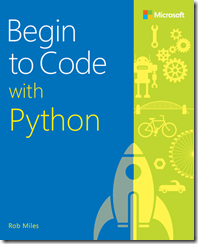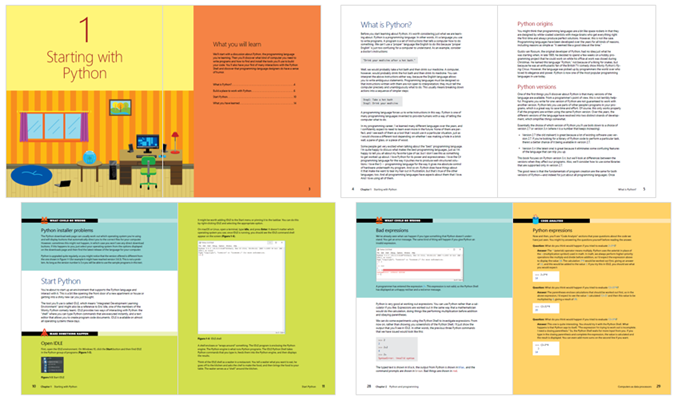New book: Begin to Code with Python
 We’re pleased to announce the availability of Begin to Code with Python (ISBN 9781509304523), by Rob Miles.
We’re pleased to announce the availability of Begin to Code with Python (ISBN 9781509304523), by Rob Miles.
Purchase from these online retailers:
Microsoft Press Store Amazon Barnes & Noble Independent booksellers – Shop local
Overview
Become a Python programmer—and have fun doing it!
Start writing software that solves real problems, even if you have absolutely no programming experience! This friendly, easy, full-color book puts you in total control of your own learning, empowering you to build unique and useful programs. Microsoft has completely reinvented the beginning programmer’s tutorial, reflecting deep research into how today’s beginners learn, and why other books fall short. Begin to Code with Python is packed with innovations, from its “Snaps” prebuilt operations to its “Make Something Happen” projects. Whether you’re a total beginner or you’ve tried before, this guide will put the power, excitement, and fun of programming where it belongs: in your hands!
Easy, friendly, and you’re in control! Learn how to…
- Get, install, and use powerful free tools to create modern Python programs
- Learn key concepts from 170 sample programs, and use them to jumpstart your own
- Discover exactly what happens when a program runs
- Approach program development with a professional perspective
- Learn the core elements of the Python language
- Build more complex software with classes, methods, and objects
- Organize programs so they’re easy to build and improve
- Capture and respond to user input
- Store and manipulate many types of real-world data
- Define custom data types to solve specific problems
- Create interactive games that are fun to play
- Build modern web and cloud-based applications
- Use pre-built libraries to quickly create powerful software
About This Book
- For absolute beginners who’ve never written a line of code
- For anyone who’s been frustrated with other beginning programming books or courses
- For people who’ve started out with other languages and now want to learn Python
- Works with Windows PC, Apple Mac, Linux PC, or Raspberry Pi
- Includes mapping of MTA exam objectives that are covered in this book, as well as an appendix with further explanation of some of the topics on the exam
Contents at a glance
Part 1: Programming fundamentals
Chapter 1 Starting with Python
Chapter 2 Python and Programming
Chapter 3 Python program structure
Chapter 4 Working with variables
Chapter 5 Making decisions in programs
Chapter 6 Repeating actions with loops
Chapter 7 Using functions to simplify programs
Chapter 8 Storing collections of data
Part 2: Advanced programming
Chapter 9 Use classes to store data
Chapter 10 Use classes to create active objects
Chapter 11 Object-based solution design
Chapter 12 Python applications
Part 3: Useful Python (Digital-only)
Chapter 13 Python and Graphical User Interfaces
Chapter 14 Python programs as network clients
Chapter 15 Python programs as network servers
Chapter 16 Create games with Pygame
Introduction
Programming is the most creative thing you can learn how to do. Why? If you learn to paint, you can create pictures. If you learn to play the violin, you can make music. But if you learn to program, you can create entirely new experiences (and you can make pictures and music too, if you wish). Once you’ve started on the programming path, there’s no limit to where you can go. There are always new devices, technologies, and marketplaces where you can use your programming skills.
Think of this book as your first step on a journey to programming enlightenment. The best journeys are undertaken with a destination in mind, and the destination of this journey is “usefulness.” By the end of this book, you will have the skills and knowledge to write useful programs.
However, before we begin, a small word of warning. Just as a guide would want to tell you about the lions, tigers, and crocodiles that you might encounter on a safari, I must tell you that our journey might not be all smooth going. Programmers must learn to think slightly differently about problem solving, because a computer just doesn’t work the same way humans do. Humans can do complex things rather slowly. Computers can do simple things very quickly. It is the programmer’s job to harness the simple abilities of the machine to solve complicated problems. This is what you’ll learn to do.
The key to success as a programmer is much the same as for many other endeavors. To become a world-renowned violin player, you will have to practice a lot. The same is true for programming. You must spend a lot of time working on your programs to acquire code-writing skills. However, the good news is that just as a violin player really enjoys making the instrument sing, making a computer do exactly what you want turns out to be a very rewarding experience. It gets even more enjoyable when you see other people using programs that you’ve written and finding them useful and fun to use.
A glimpse inside
About the author
Rob Miles has taught computer programming for over 30 years. A Microsoft MVP for Windows Development, Rob enjoys inspiring programmers at all levels. He writes his own games, programs, and poetry, has consulted on many commercial software projects, and is the author of Begin to Code with C# .
